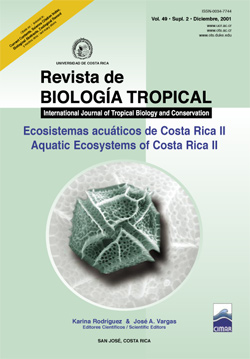Abstract
Satellite images were used to study the mangrove distribution patterns in two different climatic regions of Central America: Gulf of Fonseca in Honduras-El Salvador and Sierpe-Térraba in Costa Rica. The Gulf of Fonseca has higher temperature and solar radiation, and lower precipitation, which can explain the higher structural development and species mixing of the Sierpe-Térraba mangrove. In the latter the transition between species or between heights in the same species is clear. The automatic classification made by the Geographic Information System (IDRISI) fits well the field mangrove distribution, but it was necessary to regroup some subdivisions that represent the same land use as identified by transects and an aerial video. Mixed species and clouds produced less satisfactory results in Sierpe-Térraba indicating a need for better satellite image resolution.References
Amador, J.A., Burgos, A., Soley, F.J., Serpas, G. & A. Vargas. 1993. Remote Sensing at the Centre for Geophysical Research, University of Costa Rica. Int. J. Remote Sensing, 14(12): 2391-2401.
Anónimo. 1998. Proyecto Regional Conservación de los Ecosistemas Costeros del Golfo de Fonseca (PROGOLFO). Diagnóstico del Estado de los Recursos Naturales, Socioeconómicos e Institucionales de la Zona Costera. Comisión Centroamericana de Ambiente y Desarrollo. Area de Humedales y Zonas Costeras. UICN/ORMA. 73 p.
Anónimo. 1989. Secretaría de Recursos Naturales (SRN). Los manglares de Honduras. Un sistema único y complejo. Secretaría de Recursos Naturales. Dirección de Recursos Naturales Renovables. Unidad de Promoción, Educación y Divulgación. Tegucigalpa, Honduras. 4 p.
Asch, C. & O. Solano. 1991. Clasificación y perspectivas del manejo de los humedades de Térraba-Sierpe. Tesis. Escuela de Ciencias Geográficas. Facultad de Ciencias de la Tierra y el Mar. Universidad Nacional. Heredia, Costa Rica.
Bartlett, D.S. & V. Klemas. 1980. Evaluation of remote sensing techniques for surveying coastal wetlands. CRS-2-80, College of Marine Studies, University of Delaware, Newark, Delaware.
Campbell, J. B. 1987. Introduction to remote sensing. The Guilford Press. New York. 551 p.
Castro, A. 1989. Informe general sobre los manglares de Panamá y su relación con la productividad pesquera. Instituto Nacional de Recursos Naturales Renovables. Dirección Nacional de Desarrollo Forestal. Departamento de Manejo de Bosques Naturales. 7 p.
Godoy, J. C. 1980. Distribución, composición florística y análisis estructural del manglar de las Lisas. Tesis de Grado, Universidad de San Carlos, Guatemala.
Graedel, E. & B. Kleiner. 1985. Exploratory analysis of atmospheric data. In Murphy, A.H. & R. K. Kats (eds). Probability statistics and decision making in the atmospheric sciences. West View Press. London. 545 p.
Hardisky, M. A., V. Klemas & F. C. Daiber. 1983. Remote sensing salt marsh, biomass and stress detection. Adv. Space Res. 2(8): 219-229.
Jiménez, J. A. 1990. The structure and funtion of dry weather mangroves on the Pacific coast of Central America with emphasis on Avicennia bicolor forests. Estuaries. 13(2): 182-192.
Klemas, V. 1990. Remote sensing of physical, and biological properties of coastal waters, estuaries and wetlands. Resumen presentado en la Conferencia Espacial de las Américas. San José, Costa Rica.
Klemas, V. 1981. Technology transfer to developing countries: future use of remote sensing in biological marine resource development. CRS-1-82. College of Marine Studies, University of Delaware. Newark, Delaware.
Mainardi, V. 1996. El Manglar de Térraba-Sierpe en Costa Rica. Serie Técnica. Informe Técnico No. 284. Centro Agronómico Tropical de Investigación y Enseñanza (CATIE). Turrialba, Costa Rica. 91 p.
Magaña, V., J. A. Amador & S. Medina. 1999. The midsummer drought over Mexico and Central America. J. Climate. 12: 1577-1588.
Mata, A. & O. Blanco. 1994. La cuenca del Golfo de Nicoya, un reto al desarrollo sostenible. Universidad de Costa Rica. Ciudad Universitaria Rodrigo Facio. San José, Costa Rica. 235 p.
Salazar de Jurado, M. & R. Guillén. 1995. Estimación de las áreas de manglares en los principales bosques salados de El Salvador, mediante el uso de teledetección satelital para 1987-88 y 1994. Ministerio de Agricultura y Ganadería (MAG). El Salvador. 18 p.
Soto, R. & J. A. Jiménez. 1982. Análisis fisonómico estructural del manglar de Puerto Soley, La Cruz, Guanacaste, Costa Rica. Rev. Biol. Trop. 30(2): 161- 168.
Soto, R. & L. F. Corrales. 1987. Variaciones de algunas características foliares de Avicennia germinans (L.) L. (Avicenniaceae) en un gradiente climático y de salinidad. Rev. Biol. Trop. 35(2): 277-285.
Tabilo-Valdivieso, E. 1997. El Beneficio de los Humedales en América Central: el potencial de los humedales para el desarrollo. Elier Tabilo-Valdivieso. San José, Costa Rica. 48 p.
Terchunian A., V. Klemas, A. Segovi, A. Alvarez, B. Vasconez & L. Guerrero. 1986. Mangrove mapping in Ecuador: the impact of shrimp pond construction. Envirom. Managemen., 10(3): 345-350.
West, R. C. 1977. Tidal salt-march and mangle formations of Middle and South America. In Capman, V. J. (ed.). West Coastal Ecosystems. Elsevier Scientific Publishing Company. N. Y. 428 p.
Weyl, R. 1953. In des Mangroves, El Salvador. Natur. Volk. 83: 120-130.
##plugins.facebook.comentarios##

This work is licensed under a Creative Commons Attribution 4.0 International License.
Copyright (c) 2001 Revista de Biología Tropical


